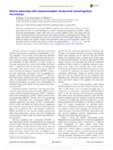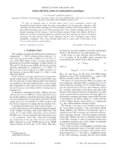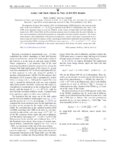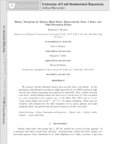|
|
Creator | Title | Description | Subject | Date |
| 51 |
 |
Saam, Brian | Asymptotic and intermediate long-time behavior of nuclear free induction decays in polycrystalline solids and powders | Free induction decay (FID) measured by nuclear magnetic resonance (NMR) in a polycrystalline solid is the isotropic average of the FIDs for individual single crystallites. It has been recently proposed theoretically and verified experimentally that the long-time behavior of single-crystal FIDs has t... | | 2012-01-01 |
| 52 |
 |
Williams, Clayton C. | Atomic force microscope-force mapping and profiling on a sub 100-Å scale | A modified version of the atomic force microscope is introduced that enables a precise measurement of the force between a tip and a sample over a tip-sample distance range of 30-150Å. As an application, the force signal is used to maintain the tip-sample spacing constant, so that profiling can be ... | Attractive force; Silicon wafer | 1987 |
| 53 |
 |
Williams, Clayton C. | Atomic scale trap state characterization by dynamic tunneling force microscopy | Dynamic tunneling force microscopy (DTFM) is applied to the study of point defects in an inter-layer dielectric film. A recent development enables simultaneous acquisition of DTFM, surface potential, and topographic images while under active height feedback control. The images show no clear correlat... | | 2014-01-01 |
| 54 |
 |
Mishchenko, Eugene | Attraction-repulsion transition in the interaction of adatoms and vacancies in graphene | The interaction of two resonant impurities in graphene has been predicted to have a long-range character with weaker repulsion when the two adatoms reside on the same sublattice and stronger attraction when they are on different sublattices. We reveal that this attraction results from a single energ... | | 2014-01-01 |
| 55 |
 |
Gondolo, Paolo | Axion cold dark matter in nonstandard cosmologies | We study the parameter space of cold dark matter axions in two cosmological scenarios with nonstandard thermal histories before big bang nucleosynthesis: the low-temperature reheating (LTR) cosmology and the kination cosmology. If the Peccei-Quinn symmetry breaks during inflation, we find more allow... | | 2010-01-01 |
| 56 |
 |
Gondolo, Paolo | Axion cold dark matter in view of BICEP2 results | The properties of axions that constitute 100% of cold dark matter (CDM) depend on the tensor-to-scalar ratio r at the end of inflation. If r ¼ 0.20 þ0.07 −0.05 as reported by the BICEP2 Collaboration, then "half" of the CDM axion parameter space is ruled out. Namely, in the context of single-fie... | | 2014-01-01 |
| 57 |
 |
Wu, Yong-Shi | BPS R-balls in N = 4 SYM on R × S3, quantum Hall analogy and AdS/CFT holography | In this paper, we propose a new approach to study the BPS dynamics in N = 4 supersymmetric U(N) Yang-Mills theory on R × S3, in order to better understand the emergence of gravity in the gauge theory. Our approach is based on supersymmetric, space-filling Q-balls with R-charge, which we call R-ball... | | 2006-06-01 |
| 58 |
 |
Symko, Orest George | Background signals in SQUID magnetometers | Since a SQUID magnetometer is an extremely sensitive device capable of detecting minute magnetic flux changes in a sample, it will also detect unwanted signals from materials near the magnetometer. The presence of temperature dependent "background signals" limits the accuracy of measurements of ... | SQUID magnetometer; Background signals | 1974 |
| 59 |
 |
Sokolsky, Pierre | Backward production in π-p→pπ+π-π- at 8 GeV/c* | We have studied backward baryon and meson production in π'p → pπ+pπ +π-π- at 8.0 GeV/c using a streamer chamber triggered by the detection of a fast forward proton. Our data sample (1227 events) displays prominent N*p and N*f quasi-two-body production. These states are investigated with rega... | | 1976-01 |
| 60 |
 |
Mattis, Daniel C. | Band theory of ferromagnetism, antiferromagnetism, and spin waves | Intra-atomic exchange (Hund's rule mechanism) and Heisenberg nearest-neighbor exchange are examined for their role in the ferromagnetism of metals with degenerate bands. The equations of motion of spin waves valid near T=0°K are derived, and a number of branches are found. When the equations are ... | Orbital degeneracy; Indirect exchange theory; Band theory | 1964 |
| 61 |
 |
DeTar, Carleton | Baryon density correlations in high temperature hadronic matter | As part of an ongoing effort to characterize the high temperature phase of QCD, in a numerical simulation using the staggered fermion scheme, we measure the quark baryon density in the vicinity of a fixed test quark at high temperature and compare it with similar measurements at low temperature and ... | Baryon density; Staggered fermions; Quark plasma | 1994-06 |
| 62 |
 |
Vardeny, Zeev Valentine | Below-gap excitation of ∏-conjugated polymer-fullerene blends: implications for bulk organic heterojunction solar cells | We used a variety of optoelectronic techniques such as broadband fs transient and cw photomodulation spectroscopies, electroabsorption, and short-circuit photocurrent in bulk heterojunctions organic solar cells for studying the photophysics in ∏-conjugated polymer-fullerene blends with below-gap... | pi-conjugated polymers; Fullerene blends; Below-gap excitations; Bulk heterojunctions; Bulk organic heterojunction solar cells; Photophysics | 2008-07 |
| 63 |
 |
Bromley, Benjamin C. | Binary disruption by massive black holes: hypervelocity stars, S stars, and tidal disruption events | We examine whether disrupted binary stars can fuel black hole growth. In this mechanism, tidal disruption produces a single hypervelocity star (HVS) ejected at high velocity and a former companion star bound to the black hole. After a cluster of bound stars forms, orbital diffusion allows the black ... | | 2012-01-01 |
| 64 |
 |
Mattis, Daniel C. | Bond asymmetry and high-Tc superconductivity | We propose a simple mechanism, anchored in weak-coupling BCS theory, which ties together the following facts: high Tc; quasi two dimensionality; orthorhombic distortion and/or disordered lines of oxygen; proximity to a metal-insulator transition; and anomalously small isotope effects. | Distortion; Singularity; Oxygen | 1987 |
| 65 |
 |
Wu, Yong-Shi | Bosonization of one-dimensional exclusons and characterization of Luttinger liquids | We achieve a bosonization of one-dimensional ideal gas of particles obeying exclusion statistics A (so called A exclusons) at low temperatures, resulting in a new variant of c = 1 conformal field theory with compactified radius R = √1/λ. These ideal excluson gases exactly reproduce the low-7 crit... | Bosonization; Exclusons; Ideal gas; Luttinger liquids | 1995-07 |
| 66 |
 |
Mattis, Daniel C. | Bound exciton and hole: an exactly solvable three-body model in any number of dimensions | A three-body problem, concerning two holes in a nondegenerate valence band and a single electron in a conduction band, with strong short-range interactions, is solved exactly in any number of dimensions. The binding depends nontrivially on the ratio of the valence to conduction bandwidths (i.e., on ... | Three-body problem; Trion; Bond energies | 1982-09 |
| 67 |
 |
Lupton, John Mark | Bragg scattering from periodically microstructured light emitting diodes | We present a simple method of generating a periodic wavelength scale structure in the optically active layer of a light emitting diode. This is achieved by solution deposition of a light emitting polymer on top of a corrugated substrate. The periodic structure allows waveguide modes normally trapped... | Bragg scattering; Periodic wavelength scale structure | 2000 |
| 68 |
 |
Wu, Yong-Shi | Braid group and anyons on a cylinder | In this paper we present a careful reexamination of anyons on a cylinder (or annulus), starting from the braid-group analysis. Proper attention is paid to the topological features arising from the existence of noncontractible loops. The rule for putting anyons on a square lattice has to be modified ... | Braid group; Annulus | 1991-02 |
| 69 |
 |
Wu, Yong-Shi | Braid group, gauge invariance, and topological order | Topological order in two-dimensional systems is studied by combining the braid group formalism with a gauge invariance analysis. We show that flux insertions (or large gauge transformations) pertinent to the toroidal topology induce automorphisms of the braid group, giving rise to a unified algebrai... | Braid group; Topological order; Zero temperature; Two-dimensional systems | 2006-07 |
| 70 |
 |
Wu, Yong-Shi | Brane creation in M(atrix) theory | We discuss, in the context of M(atrix) theory, the creation of a membrane suspended between two longitudinal five-branes when they cross each other. It is shown that the membrane creation is closely related to the degrees of freedom in the off-diagonal blocks which are related via dualities to the ... | | 1998-02 |
| 71 |
 |
Mishchenko, Eugene | Breached superfluidity via p-wave coupling | Anisotropic pairing between fermion species with different Fermi momenta opens two-dimensional areas of gapless excitations, thus producing a spatially homogeneous state with coexisting superfluid and normal fluids. This breached pairing state is stable and robust for arbitrarily small mismatch and ... | Spin-orbit coupling; Gapless excitations; Cooper instability | 2005-03 |
| 72 |
 |
Lupton, John Mark | Bright electroluminescence from a conjugated dendrimer | Photoluminescence and electroluminescence (EL) from a conjugated dendrimer consisting of three distyrylbenzene units linked by a central nitrogen atom as core and meta-linked biphenyl units as dendrons were investigated. The conjugated dendrimer emits green light and shows photoluminescence quantum ... | Conjugated dendrimer | 2002 |
| 73 |
 |
DeTar, Carleton | B̄→D*ℓν̄ form factor at zero recoil from three-flavor lattice QCD: a model independent determination of [Vcb] | We present the first lattice QCD calculation of the form factor for B→ D* lv with three flavors of sea quarks. We use an improved staggered action for the light valence and sea quarks (the MILC configurations), and the Fermilab action for the heavy quarks. The form factor is computed at zero recoi... | Staggered quarks | 2009-01 |
| 74 |
 |
DeTar, Carleton | B→πlν semileptonic form factor from three-flavor lattice QCD: a model-independent determination of [Vub] | We calculate the form factor f+(q2) for B-meson semileptonic decay in unquenched lattice QCD with 2 + 1 flavors of light sea quarks. We use Asqtad-improved staggered light quarks and a Fermilab bottom quark on gauge configurations generated by the MILC Collaboration. We simulate with several light... | Semileptonic decay | 2009-03 |
| 75 |
 |
Wu, Yong-Shi | C-functions of noncommutative Yang-Mills theory from holography | In this paper we study non-commutative Yang-Mills theory (NCYM) through its gravity dual. First it is shown that the gravity dual of an NCYM with self-dual θ-parameters has a Lagrangian in the form of five-dimensional dilatonic gravity. Then we use the de-Boer-Verlinde-Verlinde formalism for holog... | | 2000-05-01 |

























